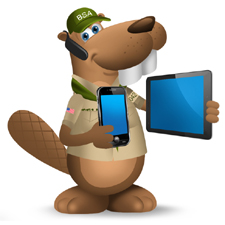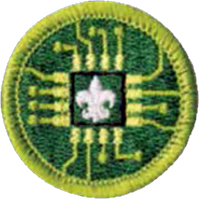Digital Technology


Resources
- Digital Technology Merit Badge Pamphlet
- Digital Technology Merit Badge Class Preparation Page
- Digital Technology Merit Badge Workbook
- Scoutmaster Bucky's Merit Badge Advancement Quick Reference
- Scoutmaster Bucky's Acknowledgement Form
Digital Technology Requirements
Current Scouts BSA requirements
as of December 6, 2025
as of December 6, 2025
1.
View the Personal
Safety Awareness "Digital Safety" video (with your parent or guardian's
permission).
2.
Do the following:
a.
Give a brief history of the changes in digital technology over time.
Discuss with your counselor how digital technology in your lifetime
compares with that of your parent's, grandparent's, or other adult's
lifetime.
b.
Describe what kinds of computers or devices you imagine might be
available when you are an adult.
3.
Do the following:
a.
Explain to your counselor how text, sound, and pictures are digitized
for storage.
b.
Describe the difference between lossy and lossless data compression,
and give an example where each might be used.
c.
Describe two digital devices and how they are made more useful by their
programming.
d.
Discuss the similarities and differences between computers, mobile
devices, and gaming consoles.
e.
Explain what a computer network is and the difference between a local
area network (LAN) versus a wide area network (WAN).
4.
Do the following:
a.
Explain what a program or software application or "app" is and how a
computer uses a CPU and memory to execute it.
b.
Name four software programs or mobile apps you or your family use, and
explain how each one helps you.
c.
Describe what malware is, and explain how to protect your digital
devices and the information stored on them.
5.
Do the following:
a.
Describe at least two different ways data can be transferred through
the internet.
b.
Using an internet search engine (with a parent or guardian's
permission), find ideas from at least three different websites about
how to conduct a troop court of honor or campfire program. Present the
ideas to your counselor and explain how you used a search engine to
find this information.
c.
Use a web browser to connect to an HTTPS (secure) website (with your
parent or guardian's permission). Explain to your counselor how to tell
whether the site's security certificate can be trusted, and what it
means to use this kind of connection.
6.
Do THREE of the following. For each project you complete, copy the files to
a backup device and share the finished projects with your counselor.
a.
Using a spreadsheet or database program, develop a food budget for a
patrol weekend campout OR create a troop roster that includes the name,
rank, patrol, and telephone number of each Scout. Show your counselor
that you can sort the roster by each of the following categories: rank,
patrol, and alphabetically by name.
b.
Using a word processor, write a draft letter to the parents of your
troop's Scouts, inviting them to a troop event.
c.
Using a graphics program, design and draw a campsite plan for your
troop OR create a flyer for an upcoming troop event, incorporating text
and some type of visual such as a photograph or an illustration.
d.
Using a presentation software program, develop a report about a topic
approved by your counselor. For your presentation, create at least five
slides, with each one incorporating text and some type of visual such
as a photograph or an illustration.
e.
Using a digital device, take a picture of a troop activity. Send or
transfer this image to a device where it can be shared with your
counselor.
f.
Make a digital recording of your voice, transfer the file to a
different device, and have your counselor play back the recording.
g.
Create a blog and use it as an online journal of your Scouting
activities, including group discussions and meetings, campouts, and
other events. Include at least five entries and two photographs or
illustrations. Share your blog with your counselor. You need not post
the blog to the internet; however, if you choose to go live with your
blog, you must first share it with your parent or guardian AND
counselor AND get their approval.
h.
Create a webpage for your troop, patrol, school, or place of worship.
Include at least three articles and two photographs or illustrations.
Include at least one link to a website of interest to your audience.
You need not post the page to the internet; however, if you decide to
do so, you must first share the webpage with your parent or guardian
AND counselor AND get their approval.
7.
Do the following:
a.
Explain to your counselor each of these protections and why they exist:
copyright, patents, trademarks, trade secrets.
b.
Explain when it is permissible to accept a free copy of a program from
a friend.
c.
Discuss with your counselor an article or (with your parent or
guardian's permission) a report on the internet about a recent legal
case involving an intellectual property dispute.
8.
Do TWO of the following:
a.
Describe why it is important to properly dispose of digital technology.
List at least three hazardous chemicals that could be used to create
digital devices or used inside a digital device.
b.
Explain to your counselor why it is important to use a certified
recycler of digital technology hardware or devices.
c.
Do an internet search for an organization that collects discarded
digital technology hardware or devices for repurposing or recycling.
Find out what happens to that waste. Share with your counselor what you
found.
d.
Visit a recycling center that disposes of digital technology hardware
or devices. Find out what happens to that waste. Share what you learned
with your counselor.
e.
Find a battery recycling center near you and find out what it does to
recycle batteries. Share what you have learned with your counselor
about the proper methods for recycling batteries.
9.
Do ONE of the following:
a.
Identify three career opportunities that involve digital technology.
Pick one and investigate the education, training, and experience
required for this profession. Discuss this with your counselor, and
explain why this profession might interest you.
b.
Visit a business or an industrial facility that uses digital
technology. Describe four ways digital technology is being used there.
Share what you learned with your counselor.